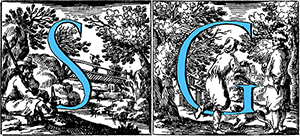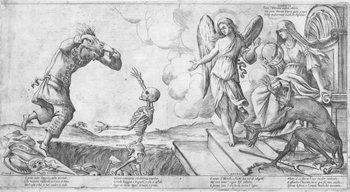
MITELLI Giuseppe Maria
(Bologna 1634 – 1718)
Engraver and painter born in Bologna, initially he was a student of his father Agostino, also a painter, and later he studied painting and graphic art alongside with Simone Cantarini, Francesco Albani, Guercino and Flaminio Torri.
In 1658 he went to Spain to follow his father and in Madrid he was especially involved in reproducing drawings from some of the most important canvases in the real collection and in particular by Titian and Van Dyck.
The following year, while his father continued his activities in Madrid, Giuseppe Maria went to Venice where he made drawings still by Titian, Veronese and Tintoretto.
When he heard the news of his father’s death (1660) he probably returned to Madrid to take possession of his father’s property. In 1661 he was back in Bologna.
Of his vast pictorial activity it remains today a rather small corpus oscillating between classic models and popular subjects, especially treated in his graphic works.
Started with all probability by his father, he devoted his greatest efforts to engraving, leaving about six hundred plates performed in very high prevalence by etching.
1660 is the date of the series of etchings “Arti per via”, forty copperplates illustrating the various trades carried out by dealers and pedlars in the streets of Bologna, derived from drawings by Annibale Carracci and published by the Roman Giovanni Giacomo De Rossi.
In the first phase of his career, Mitelli had to try to accredit himself primarily as a translation engraver, working on some classics of Bolognese and Venetian painting.
In this activity there is the realization, in 1663, of the “Enea vagante”, a group of 12 etchings dedicated to Leopoldo de ‘Medici and based on Flaminio Torri’s drawings, reproducing the stories of the troyano hero, frescoed by Carracci, in Fava Palace in Bologna.
Famous are his prints of moral and didactic character, which include sacred and profane allegories, political satire, proverbs and society games, often accompanied by brief captions or dialect proverbs.
Famous series show a flourishing production of popular theme images, which became a kind of Mitelli etchings trademark. The Proverbs figurated (1678), a series dedicated to Francesco Maria de ‘Medici and composed of 48 etchings, illustrate many of the most popular sayings by interacting with the linguistic and visual codes.
In 1683, he obtained a great success, even internationally, with the original invention of the Alphabet in a dream, in which each sheet illustrates a letter obtained by the conjunction of different figures.
On the end of the century, he also signed a further didactic series, composed by 12 plates depicting the Senses, the Seasons and the Fates, surrounded by anatomical details, faces and masks.
He died in Bologna in February 1718.




